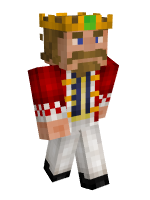I am not going to lie. Tanks in CCNet are really freaking cool. They're already decently balanced (unlike some things) and are very useful... in sieges. There are a lot more uses for tanks that I think would make the game very interesting. These ideas are not meant to be implemented all together, but even one of these ideas making it into the server would benefit it, I believe.
1. Tanks should have a new class; the Light Tank. This tank would be faster, have an even shorter rotation speed, and have a lighter cannon that is more powerful than the IFV cannon, but less powerful than the standard tank cannon. This tank would have a very low terracotta percentage and would act as a scouting and/or intercepting vehicle. The Light Tank would have a higher render distance to allow for reconnaissance missions. This tank would also be useful to not only provide an interesting and dynamic vehicle to the siege battlefield by, for example, flanking heavier tanks to deal damage from the sides, providing intelligence to tanks on the battlefield, or attacking artillery positions behind enemy lines, the Light Tank would also make it so that tanks in general would be useful outside of sieges. Yes, Zeppelins or cavalry can be used for scouting, however zeppelins are large and easy to see, and cavalry are vulnerable and completely exposed to small arms fire. The Light Tank would allow for a middle ground as a vehicle that is not strong enough to cause havoc and and mass destruction like heavier tanks, but carries enough punch to give it a dynamic use in the battlefield or in scouting.
2. Tanks should have a camouflage mechanic. Basically, a certain color of blocks would LOWER the radius in which a tank can be detected with the contacts sign depending on the biome the tank is in and the color of the camouflaged. For example, a tank consisting of green concrete and terracotta should be harder to detect/see in a forest/grasslands biome, allowing for a tactical advantage in combat, however should that tank enter a desert or a mountainous biome, the tank's green color would contrast heavily with the terrain around it and would have a HIGHER radius in which it can be detected with the contacts sign. Colors such as grey, white, black, and brown should be somewhere in the middle in all biomes and bright colors such as pink, light blue, and red should have the highest radius of detection. This mechanic would allow for specialized units for specific biomes and reward players who put in the effort to make those specialized units. It would also make it harder for random attackers to cross massive areas of land and attack due to those tanks entering different biomes and being easily detected in those certain biomes. To allow for easier use of this camouflage mechanic, perhaps there could be a tool that, at a price, can change the general palate of the tank. Slabs, stairs, trapdoors, etc. would be exempt from this mechanic and the blocks below them would be counted. The lowered detection radius should be based on a percentage of the blocks used in the tank.
3. Similar to the idea of tanks having varying detection based on their color palate, tanks should have a 2-5 second time in which, right after firing their cannon, have a significantly increased detection radius due to the sound of the cannon. Yes, one can hear the cannon through their audio even if it is farther than the detection range, however many people don't have audio systems that allow for directional audio. A downside to this is that experienced tank commanders will no longer have the advantage of triangulating the direction of a tank based on the sound as everyone would be able to do this.
4. Tanks should have a VERY LOW ricochet chance. On real tanks, sloped/composite armor utilizes sloped armor so that a projectile has to pass through more armor before it penetrates the tank. The basis of this ricochet mechanic would be that concrete has around a 0.8% chance of ricocheting a tank shell without damaging the tank, slabs and stairs (because they're often used to give tanks a smoother/curved look) would have a 3% chance of ricocheting, and terracotta would have a 6% chance of ricocheting. Now, to stop players from only building their tanks out of slabs/stairs, if a shell DOESN'T ricochet, it blows up. It does not pass through the block and roll the chance of ricochet again. Of course, these chances could be altered for balancing reasons, but I believe the values I provided make it so that it is both unreliable to cover your tank in slabs or stairs, yet still have the chance of a shell not penetrating armor.
5. The damage a tank shell does to TERRACOTTA and TERRACOTTA ONLY should be slightly reduced depending on the distance the shell had to travel to hit a tank's armor. It is, at times, extremely frustrating when someone in a tank shoots your tank at point blank range, does significant damage, and then somehow manages to penetrate the same amount of your tank's armor from 200 meters away. I specifically said terracotta because tanks have multiple uses other than anti-tank combat and nerfing their damage to all blocks at long range is completely unbalanced. Now, I'm not saying that if someone is hit by a tank shell from a long distance that their tank take no significant damage. I am saying that there should be a noticeable, but not big, difference in damage dealt to terracotta when struck from a distance. This would allow differing strategies in tank combat and make sieges more dynamic and force players to put more thought into each shot or where they are positioned in the battlefield.
6. This last one has almost no combat value, but only aims to make tanks more immersive. Tanks are one of the only vehicles in the real world that can be salvaged even after being destroyed. Tanks in CCNet should do the same thing. One of the most symbolic parts of war is seeing crippled tanks lying on the side of the road, nothing but charred remains of twisted steel. Different types of destruction to a tank would make tank battles just... cooler than a giant crater following the destruction of a tank after it (very oddly) sinks into the ground (which is weird and shouldn't happen).
A) If a tank's CANNON is destroyed, an explosion should occur at the tank and cripple it, rendering it helpless with no way to shoot back. The tank may be incapable of moving depending on where the different parts of it are located. This leaves no chance of repair.
B) If the tank's AMMUNITION MAGAZINE, then kaput. A massive explosion will blow apart the cannon (and possibly the entire tank) and completely cripple the tank, rendering it destroyed. This leaves no chance of repair.
C) If a tank's REDSTONE BLOCKS are destroyed, everything else about the tank is capable of being completely unharmed. The cannon can still fire and nothing should explode, however the tank cannot move and following the end of combat, the tank is released. This is easily repaired post-battle.
D) If a tank's FURNACE BLOCK is destroyed, the entire tank will burst into flames and cease movement. The pilot is set on fire and pulled out of whatever periscope mode they're in. The tank is completely crippled and cannot fire its cannon or move. This can be repaired, however it will be expensive.
E) If a tank simply SUSTAINS TOO MUCH DAMAGE during combat but none of it's vital parts are destroyed, the tank should still be operable during combat, however after combat is over, the tank is released. This is repairable.
F) Perhaps a tow truck mechanic would allow damaged tanks to be hauled back home instead of having to bring materials to the tank manually or breaking the whole thing down for parts.
Sorry for that massive essay on tank mechanics, but I think all of these would be super interesting and have the ability to be balanced if implemented correctly.



